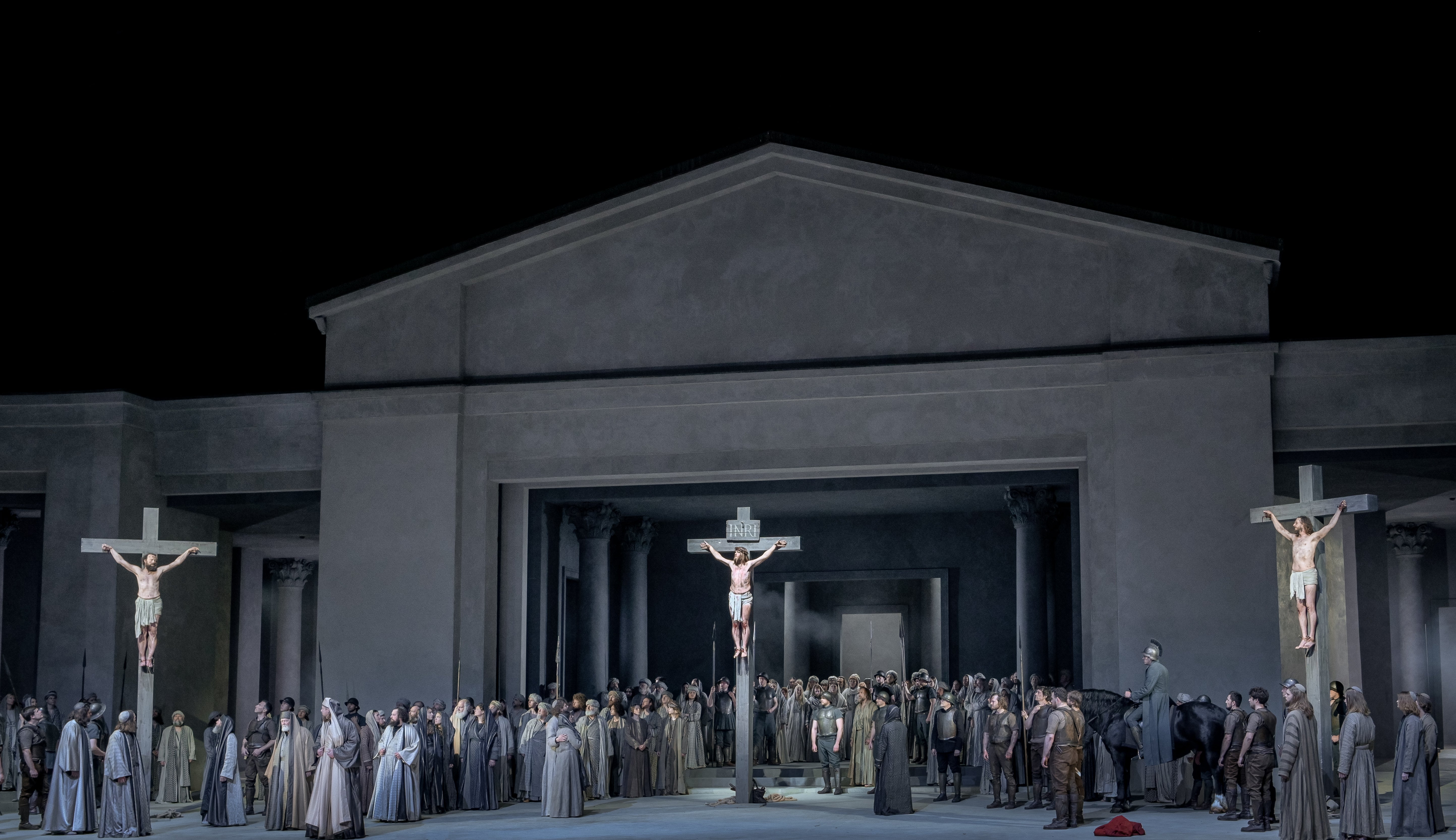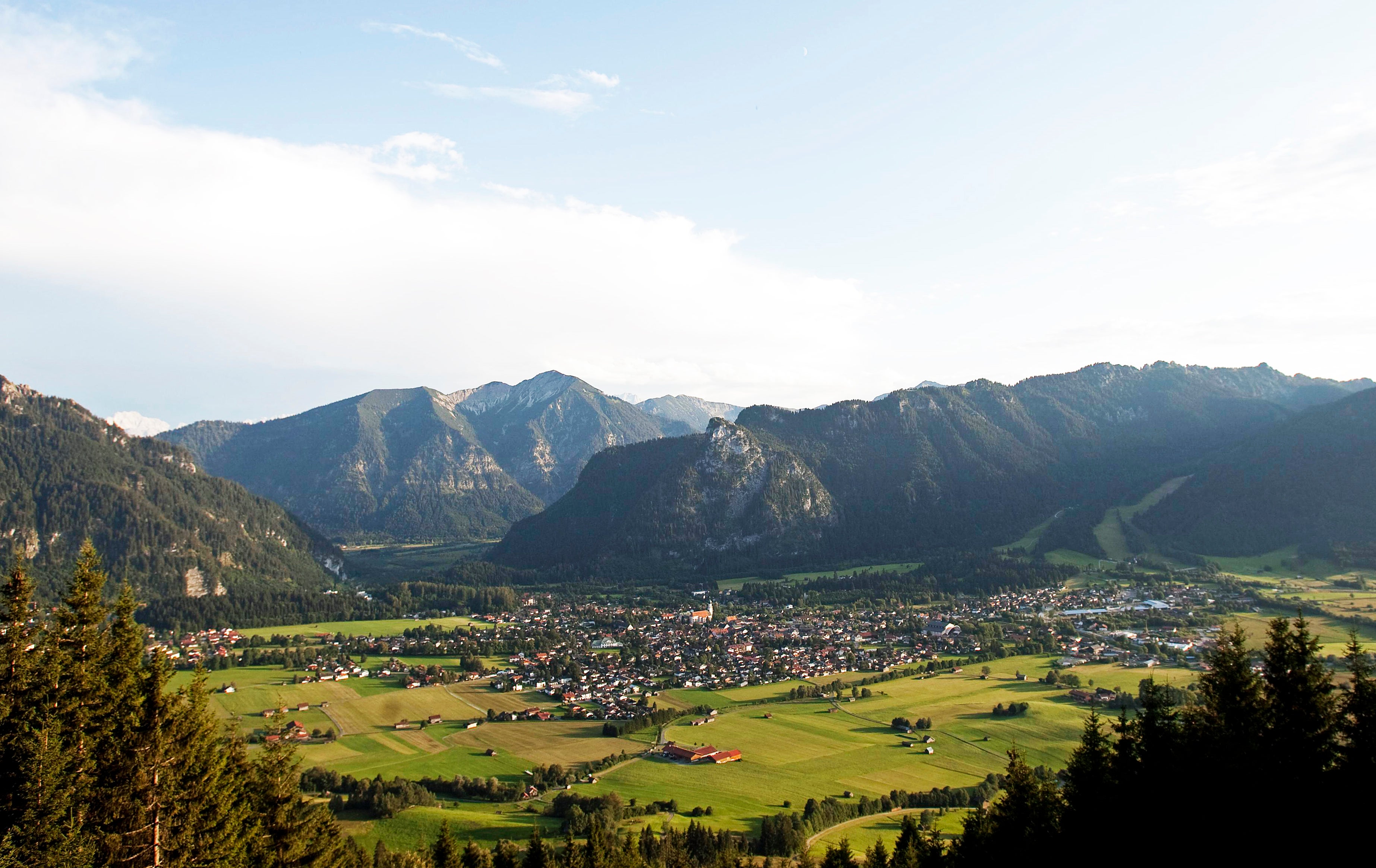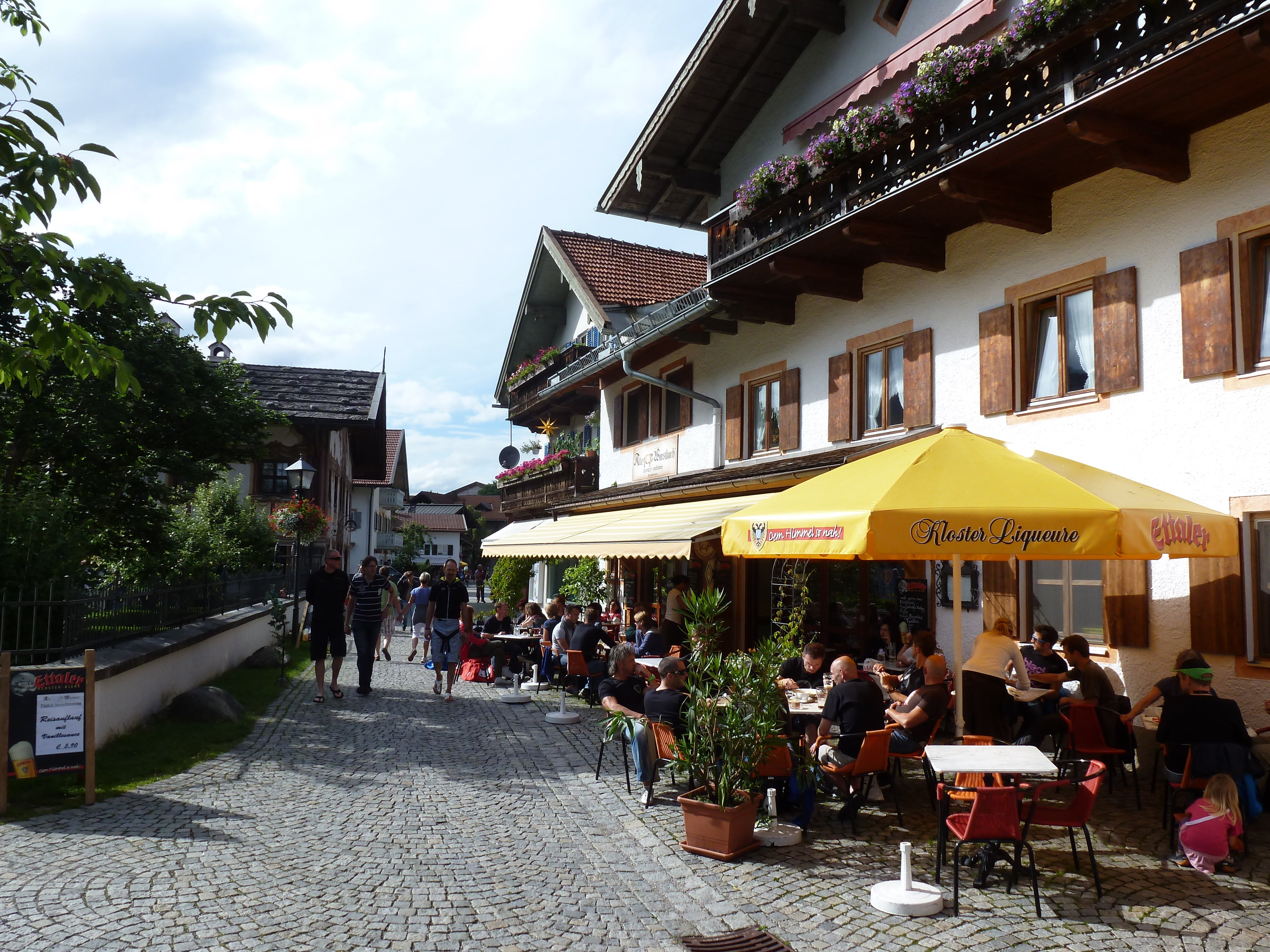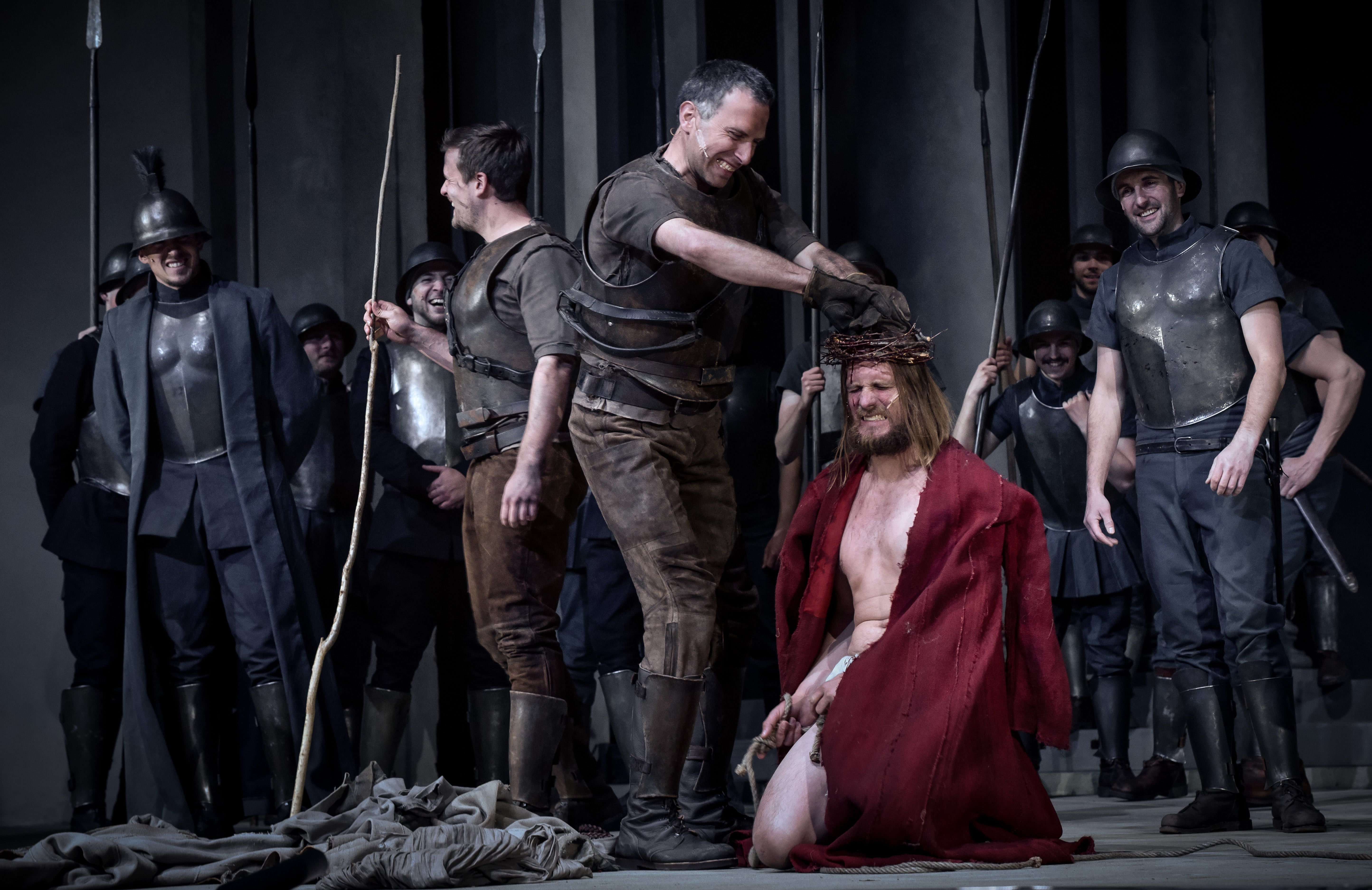The story of the Bavarian Passion play that dates back over 380 years
First performed in 1634, the ‘Oberammergau Passion Play’ has been run every 10 years since 1680 and has become an object of pilgrimage for Christians around the world, reports William Cook


Here in Oberammergau, a pretty village in the foothills of the Bavarian Alps, I’m watching one of the most disturbing spectacles I’ve seen in 50 years of theatregoing. On the stage of this outdoor theatre, against an Alpine backdrop straight out of The Sound of Music, a man is being nailed to a cross.
For anyone who’s grown up in a Christian country, surrounded by Christian imagery, the Crucifixion is so ubiquitous that some of those who do not follow the religion may find it difficult to invest it with any meaning. We’ve seen it so many times – in churches, in art galleries, in the movies – that we’ve become immune to it. It simply doesn’t seem real.
Only when you see it in the flesh do you realise what it entails. Seeing it re-enacted, right in front of you, really brings it home to you: this was one of the most horrific methods of execution ever devised, performed upon a man whom two billion people believe to be the son of God.
This crucifixion scene is the climax of the Oberammergau Passion Play, a dramatic re-enactment of the last week in the life of Jesus Christ. I first came here to see it 22 years ago, having rediscovered my Christian faith. But you don’t need to be a Christian to be fascinated by this Passion play. Whether you’re a follower of another faith or someone of no faith at all, you can’t help but be intrigued by this vivid spectacle, and the extraordinary story behind it.
Most of the time Oberammergau is a sleepy place, but once every 10 years it becomes a hive of intense activity, and this is one of those years. Throughout this summer, its Passion play will be performed here every day, in front of nearly 5,000 spectators per performance – around 100 performances and 500,000 spectators altogether. The cast all come from Oberammergau (unless you live in the village, you’re not allowed to take part) and the play is only ever performed here. It’s never been filmed or televised.
Around half the villagers are involved (about 2,500, out of a population of around 5,000) and this epic production is so professional it’s hard to believe they’re all amateurs. So how did this spectacle become renowned throughout the world? And how did it all begin?

The Passion play, so the story goes, was first performed in Oberammergau in 1634, the result of a solemn promise made to God. Then as now, Europe had been ravaged by plague, and many Oberammergauers had died. The surviving villagers swore they’d perform a Passion play, whereupon the deaths miraculously ceased. Since then, the inhabitants of this village have performed their play every 10 years, without fail. It’s now the world’s most famous Passion play and by far the oldest.
Well, that’s the story, and it’s a good story, but it’s not entirely accurate. Oberammergau was ravaged by plague, but there was nothing exceptional about the death rate here, or the speed of its cessation. Mortalities rose and fell and eventually abated, but they followed a typical pattern.
In 1634, the Oberammergauers resolved to perform a Passion play, but there was nothing unusual about this undertaking. Passion plays were common throughout Bavaria – and throughout Europe – at that time. Even if such a play had never been performed in Oberammergau before – which seems unlikely – there were plenty of similar plays performed in other villages nearby. What made Oberammergau’s play remarkable was that it was the only one which survived.
Industrialisation not only made travelling to places like Oberammergau a lot easier – it also fuelled nostalgia for an imagined past, uncorrupted by modernity
The Oberammergauers performed their Passion play every year until 1680, whereupon they decided to just perform it every 10 years instead. It became a popular event, but only on a local level. Around 14,000 people saw the 1750 production, a considerable number for a local show, but only a fraction of the audience which would flock here in years to come.
The descendants of medieval “mystery plays”, often featuring broad slapstick, Passion plays were popular with the common people, but the powers that be didn’t like commoners interpreting the Gospel story for themselves. In 1770 Elector Maximilian, the ruler of Bavaria banned all Passion plays. “The stage is no place for the greatest mystery of our holy religion,” he decreed. Bavaria’s passion plays fell into abeyance. Most were never revived.
However, in 1780 Oberammergau received a rare reprieve. These villagers were allowed to perform their play again, under the supervision of the nearby monastery at Ettal. Before Maximilian’s blanket ban, this Passion play had merely been one among many. Now, it was a rarity of a bygone age.
The OberammergauPassion Play was performed every 10 years from then on, but for a long time, it remained a fairly parochial affair. In 1830 the total audience was 13,000, slightly less than it had been 80 years before. Yet over the next 30 years, visitor numbers exploded – 100,000 people saw the 1860 production. Had Bavaria been gripped by an outbreak of religious mania? Hardly. Rather, the Passion play had become an international tourist attraction.

Several factors combined to put the Passion play on the international map. Having survived Maximilian’s cull, its longevity made it respectable and having banned it in a previous century, the Bavarian monarchy now embraced it. Where aristocracy leads, the bourgeoisie are bound to follow. Well-heeled visitors arrived from Europe, even as far afield as Britain. The Prince of Wales paid a visit, and Thomas Cook organised package tours, allowing Britain’s newly moneyed middle classes to follow in his regal footsteps.
The Passion play also benefitted from the Romanticism of the Victorian era. Industrialisation not only made travelling to places like Oberammergau a lot easier – it also fuelled nostalgia for an imagined past, uncorrupted by modernity. With some skilful editing, Oberammergau was made to fit this bill. Victorian travel writers depicted it as a remote, Alpine hideaway whose rustic inhabitants were unsullied by the secular values of the outside world.
Like a lot of travel writing, this was an absurd exaggeration. Oberammergau was small and quaint, and it took a while to get there, but it was hardly inaccessible. A significant staging post on one of Europe’s oldest trading routes, its main industry was carving religious sculptures, which were exported to churches all across the continent.
For bourgeois visitors from abroad, it was an ideal destination. It wasn’t that hard to get to, and you didn’t have to rough it when you got here, but it still felt exotic, and thanks to Thomas Cook & Co it became a popular place of pilgrimage. Ironically, even though Oberammergau (like most of Bavaria) was devoutly Catholic, most of these pilgrims came from Protestant countries: in particular Britain and the USA. Maybe this theatrical experience gave them something which their plainer form of worship lacked.

The 19th century was the golden age of the Oberammergau Passion Play. During the 20th century, it was beset by catastrophes. The First World War and the Spanish Flu epidemic (which led to the postponement of the play, from 1920 to 1922) were both devastating, but it was the rise of the Nazis which dealt the play its most serious, near-fatal, blow.
Adolf Hitler attended the 1930 production and in 1934, to mark the play’s 300th anniversary, Oberammergau staged a special performance and Hitler came along again. By now he was German Chancellor, and so his visit was front-page news. Hitler admired the play, but for all the most abhorrent of reasons. “Never has the menace of Jewry been so convincingly portrayed,” he said. Inevitably, his visit became a Nazi propaganda tool.
There’s a kind of alchemy at work here, a connection with all the other men who’ve played the part, stretching back 400 years. Talking to him, you realise this is more than just a play
The 1940 Passion play was abandoned, on account of the Second World War. When it was performed again, in 1950, the raw horror of the Holocaust cast it in an entirely different light. Jewish groups in particular were deeply unhappy with the way in which the play appeared to whip up anti-Jewish feeling by blaming the Jewish people for killing Christ.
That there were anti-Jewish tropes within this play was indisputable – they were rooted in the Gospels upon which the play was based. This was a fundamental problem for any Passion play. However, it was no longer good enough to say these elements were merely historical or theological. Even if the content of the play was no different from the content of the New Testament, there was something particularly potent about seeing it acted out before an audience of thousands. Clearly, to perform this play in German, in Germany, meant something completely different in the aftermath of the genocide that the Nazis had carried out.
This debate dragged on for decades. It wasn’t just devout Jews who were distressed. Arthur Miller and Günter Grass were among those who called for a boycott. The Vatican withdrew its blessing. At the 1970 production, there were actually some empty seats. It was hard to see a way forward.

That Oberammergau finally found a way forward, thanks to the insight and empathy of a new generation of villagers, the most prominent of whom is the play’s dynamic director, Christian Stuckl. Born and raised in Oberammergau, Stuckl appeared in the play as a child. His family have lived in Oberammergau for centuries – one of his ancestors was a victim of the plague. Stuckls have acted in the play for generations. Today Christian is one of Germany’s leading directors, and his creative team have rescued this play from its troubled past.
This is the fourth production of the Passion play that Stuckl has directed. He also directed it in 1990, 2000 and 2010, and his interpretation places Jesus Christ’s Judaism centre stage. The Last Supper is a Jewish Seder. Stuckl took his leading actors to Jerusalem, to deepen their understanding of Judaism, and it shows.
These changes were already apparent when I first saw the play in 2000, and seeing it again today, 22 years later, I’m pleased to find the wonder of my first encounter with this drama has survived. From Palm Sunday to Good Friday, it’s an incredible spectacle – hundreds of people onstage, all amateurs, and thousands of people in the audience. This is community theatre at its finest – a drama that stretches back across the centuries, performed by generation after generation, people who all live together in the same village, united by a play. This is what the Germans mean by Heimat – that sense of belonging to a place, rather than merely passing through.

I met Stuckl on my first visit to Oberammergau, in 2000, and tonight, during the interval, I caught up with him again. The years have weathered him, but his magnetic charisma remains. “I love my job,” he tells me, “but, in Oberammergau, I feel much closer to the actors. Sometimes, I can say that I fall in love with the actors.” That love for these performers shines through in every aspect of his art.
Backstage I spoke to Rochus Rückel, who’s playing Jesus. On stage, he is passionate and intense, but here in his dressing room, he’s gentle and subdued. Born in Oberammergau, he’s studying for a Masters in Engineering. “It’s a very intensive time,” he tells me. “You have a lot of responsibility – for Oberammergau on the one hand, and on the other hand for the whole Christian community.”
There’s a kind of alchemy at work here, a connection with all the other men who’ve played the part, stretching back 400 years. Talking to him, you realise this is more than just a play. “The main thing about it is the message of Jesus,” he says, emphatically. “Poor people are his community and this is the way we will play it.”
Watching the second half, memories from my first visit come flooding back. The one that stands out a mile is my meeting with Michael Counsell, a Church of England vicar who wrote a book called Every Pilgrim’s Guide to Oberammergau. Just before Michael first came to Oberammergau, in 1984, his son was killed by a drunk driver. “It was the last thing I wanted to do,” he told me, “but our other two children persuaded us to come.”
After he’d come here, he met the driver who killed his son and found some sort of forgiveness and reconciliation. “I don’t think I could have managed it without the Passion play,” he said. “It showed me the lengths to which God was prepared to go to reconcile, to forgive me, and that God too had lost a son.”
‘The Oberammergau Passion Play’ runs until 2 October 2022. For details visit www.passionsspiele-oberammergau.de. For information about travelling to Bavaria and Oberammergau, visit Welcome to the travel destination Germany – www.germany.travel




Join our commenting forum
Join thought-provoking conversations, follow other Independent readers and see their replies
Comments